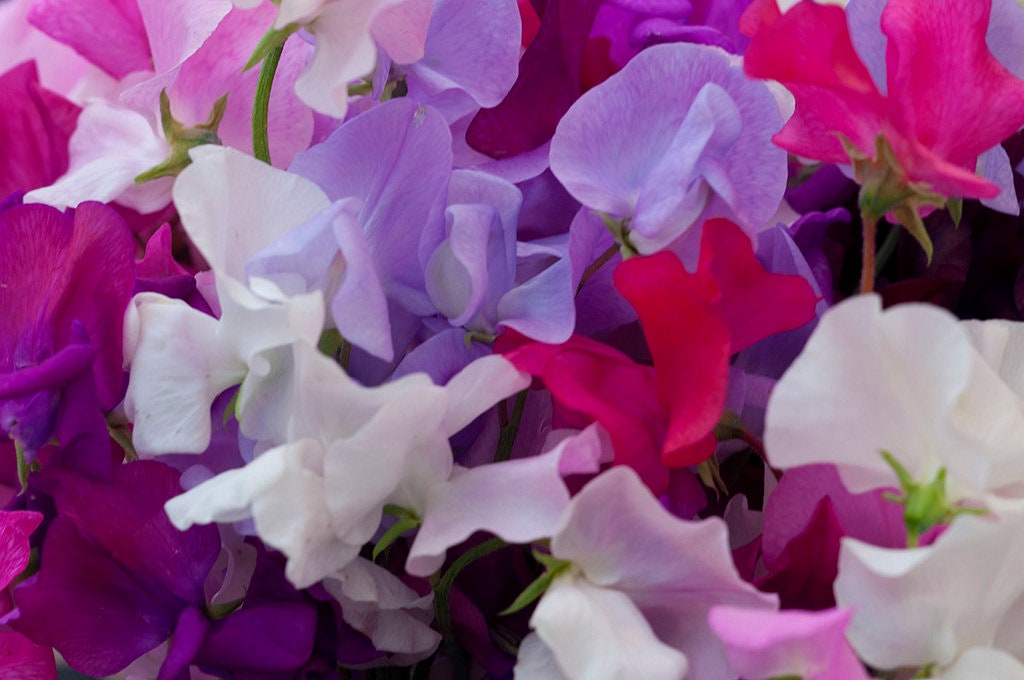R&B Floridaseeds
Sweet Pea Royal Mix Lathyrus odoratus 20 Seeds USA Company
Sweet Pea Royal Mix Lathyrus odoratus 20 Seeds USA Company
Couldn't load pickup availability
Lathyrus odoratus 'Royal Scarlet' is a variety of sweet pea (Lathyrus odoratus), which is a popular annual flowering plant. Sweet peas are well-known for their delightful fragrance, vibrant colors, and climbing habit. 'Royal Scarlet' is one of the many cultivars of sweet pea that has striking scarlet-red flowers.
Here are some key features and characteristics of Lathyrus odoratus 'Royal Scarlet':
Flowers: The most striking feature of 'Royal Scarlet' sweet pea is its deep scarlet-red flowers. The blossoms are typically large and display a lovely sweet fragrance. The flowers have a distinctive shape with a standard (large upright petal), two wings (side petals), and a keel (bottom petal) which encloses the reproductive organs.
Growth Habit: Sweet peas, including 'Royal Scarlet,' are climbing plants that use tendrils to cling to supports such as trellises, fences, or other structures. They can reach heights of 6 to 8 feet (1.8 to 2.4 meters) or even taller under the right growing conditions.
Blooming Season: 'Royal Scarlet' sweet peas typically bloom in the late spring to early summer, depending on the location and climate. The blooming period can last for several weeks, providing a beautiful display of color and fragrance in the garden.
Cultural Requirements: Sweet peas prefer cool temperatures and are often grown as cool-season annuals in regions with mild winters. They do best in well-draining, fertile soil and require regular watering to keep the soil consistently moist. Providing them with full sun to partial shade will ensure optimal flowering.
Fragrance: The fragrance of 'Royal Scarlet' sweet peas is particularly enchanting and contributes to their popularity in gardens and floral arrangements.
Cut Flowers: Sweet peas, including 'Royal Scarlet,' make wonderful cut flowers due to their attractive appearance and captivating scent. They are often used in floral arrangements and bouquets to add a touch of elegance and fragrance.
Planting: Sweet peas can be grown from seeds. It's best to sow the seeds directly into the ground in early spring or late fall, depending on your climate. You can also start them indoors a few weeks before the last frost date and transplant them outdoors once the soil has warmed up.
Support: As climbing plants, sweet peas require some form of support to grow vertically. Providing a trellis, fence, or other climbing structure will help them grow and display their flowers more effectively.
Sweet peas, including 'Royal Scarlet,' are a favorite among gardeners and flower enthusiasts, and they add a touch of charm and nostalgia to any landscape. They are also a wonderful addition to a cottage garden or any space where their fragrance can be appreciated.
Growing Instructions
Soaking: Sweet pea seeds have hard seed coats, and soaking them in water for about 12-24 hours before planting can help improve germination rates. This process softens the seed coat and encourages quicker sprouting.
Preparation of Planting Site: Select a sunny location with well-draining soil for planting your sweet peas. The soil should be fertile and free from rocks and debris. Sweet peas also prefer slightly alkaline to neutral soil pH.
Planting Time: In cooler climates, sow the seeds directly into the ground in early spring, once the soil can be worked and the danger of frost has passed. In warmer regions, you can plant sweet peas in late fall for a winter bloom or in late summer for a fall bloom.
Planting Depth: Plant the soaked seeds about 1 inch (2.5 cm) deep into the soil. Space the seeds about 2-3 inches (5-7.5 cm) apart in rows or groups.
Support: Sweet peas are climbing plants and need support to grow upright. Install trellises, fences, or other supports near the planting area before sowing the seeds, as transplanting young sweet peas can disturb their growth.
Watering: After planting, water the seeds gently but thoroughly to ensure the soil stays evenly moist. Continue to water regularly to keep the soil consistently damp but not waterlogged.
Support Maintenance: As the sweet peas grow, gently guide their tendrils onto the supports to help them climb and establish themselves.
Sweet peas are beautiful and fragrant flowers that can add charm and color to your garden or landscape. By following these steps and providing proper care, you can enjoy a lovely display of sweet pea blooms and their captivating fragrance throughout the growing season.
Materials
Materials
Shipping & Returns
Shipping & Returns
Dimensions
Dimensions
Care Instructions
Care Instructions
Share






